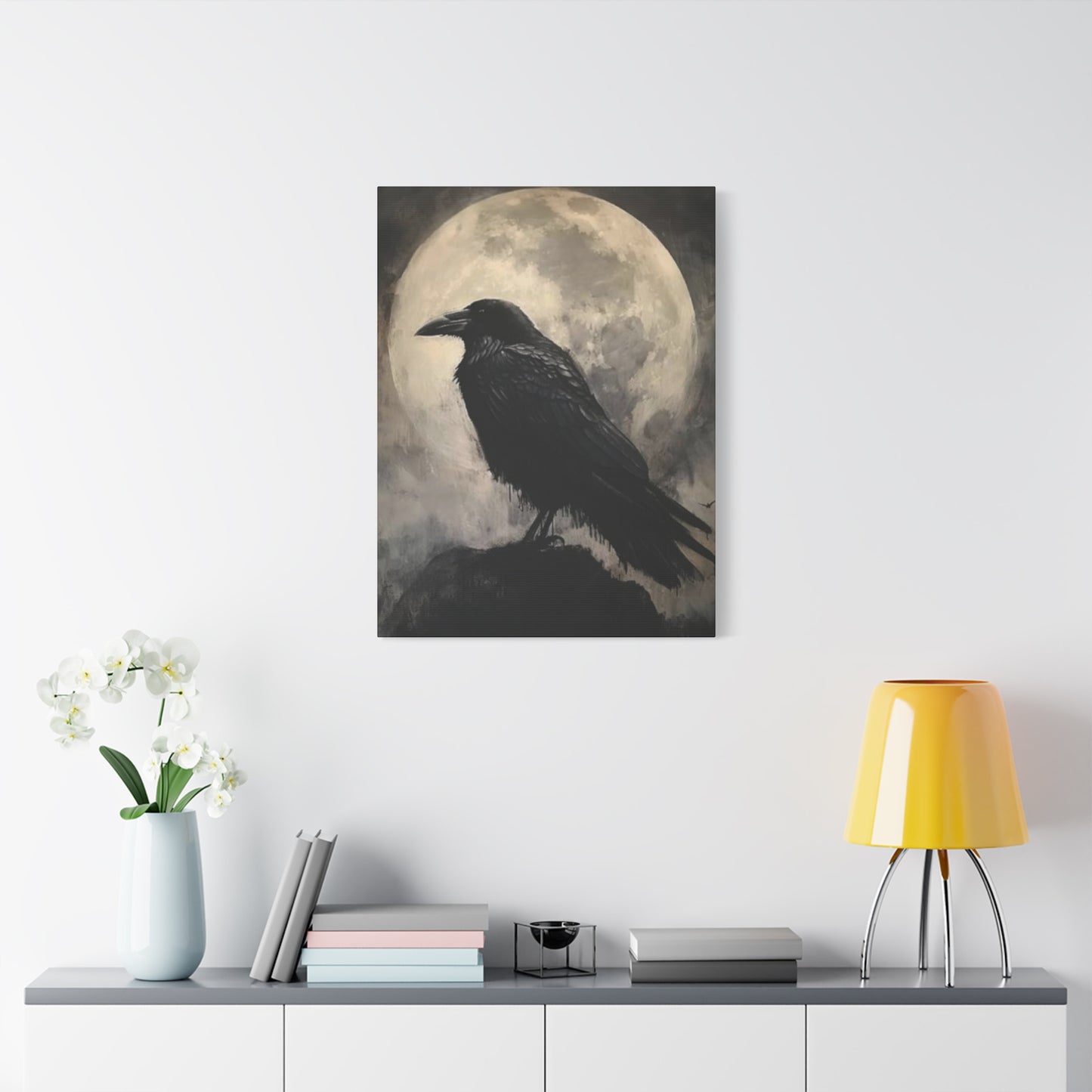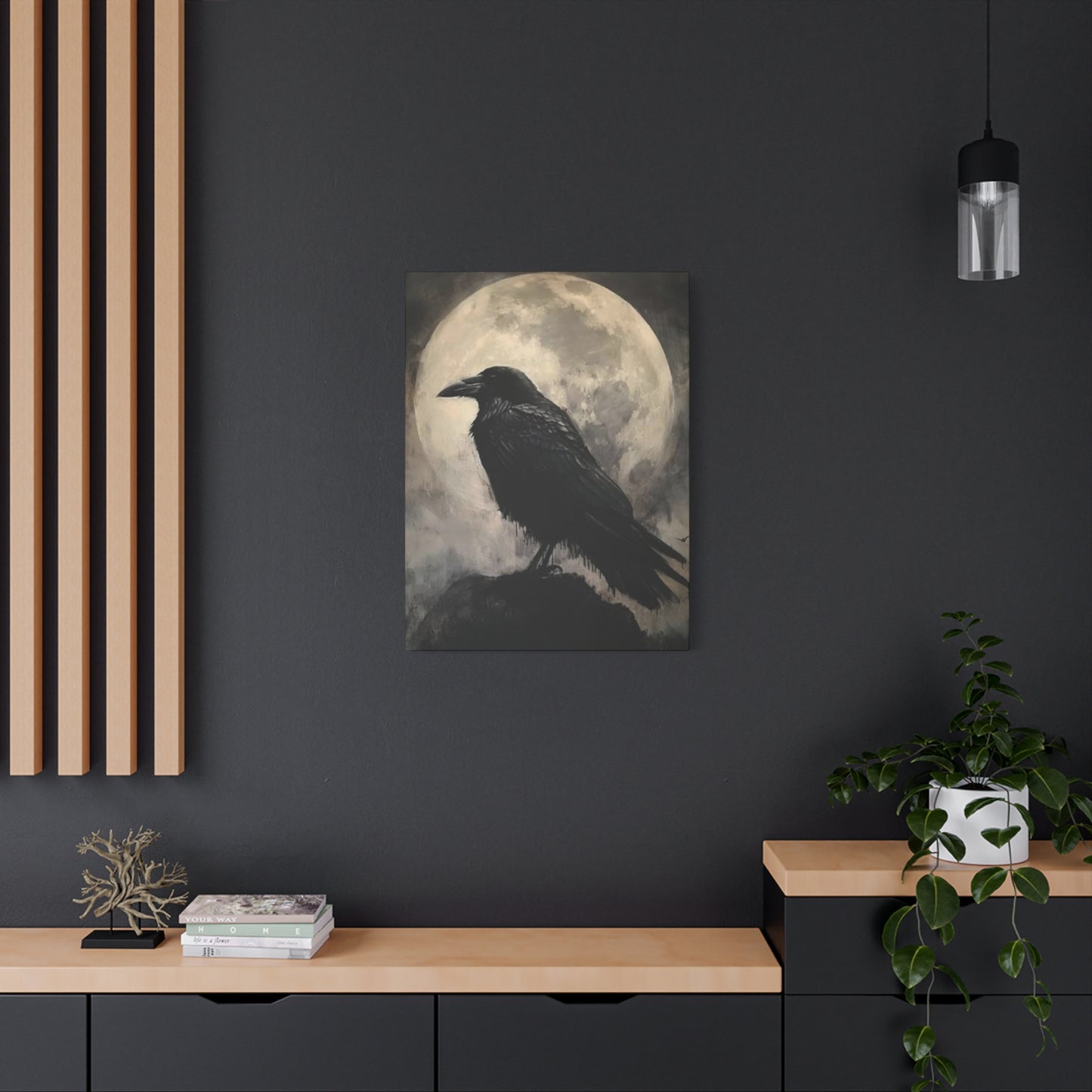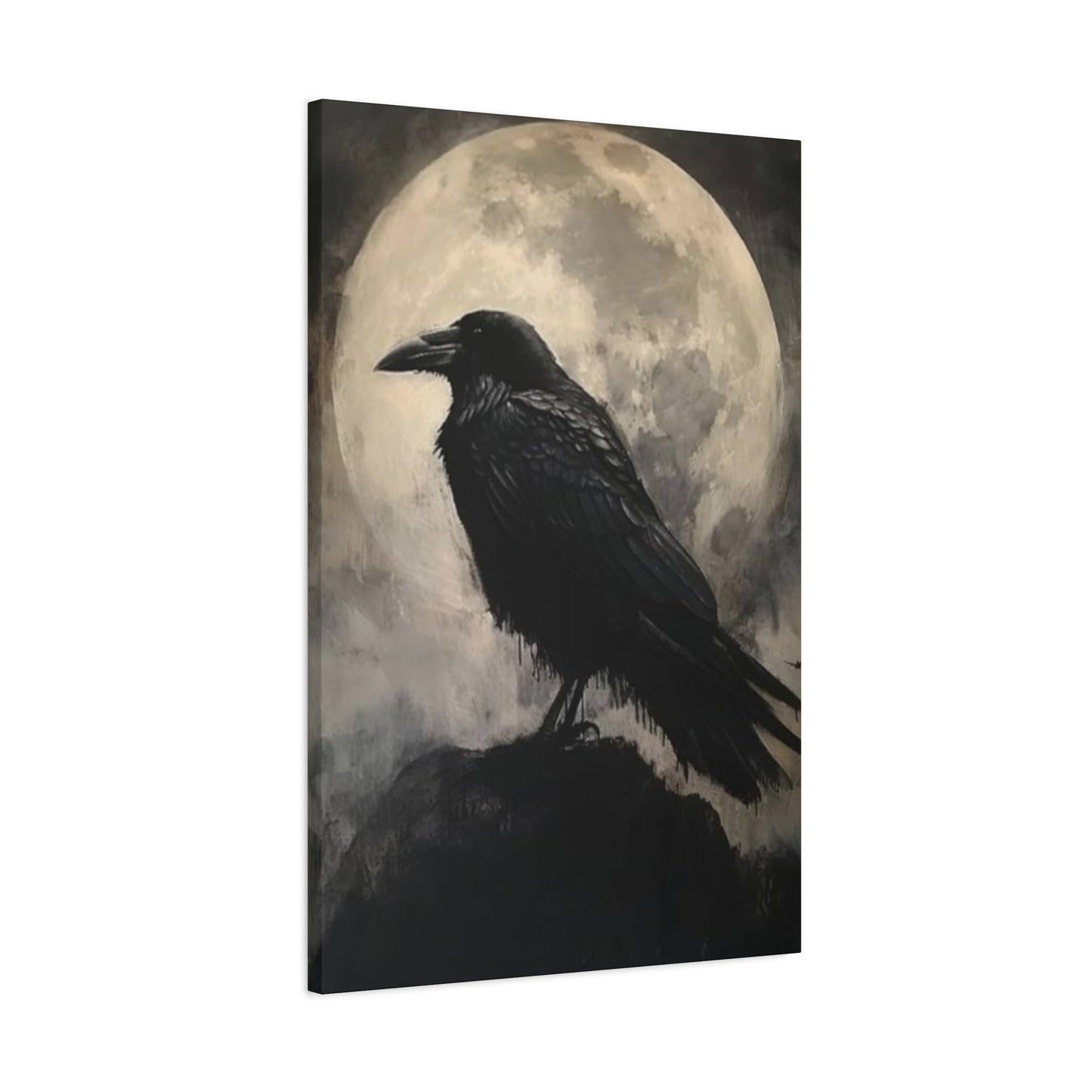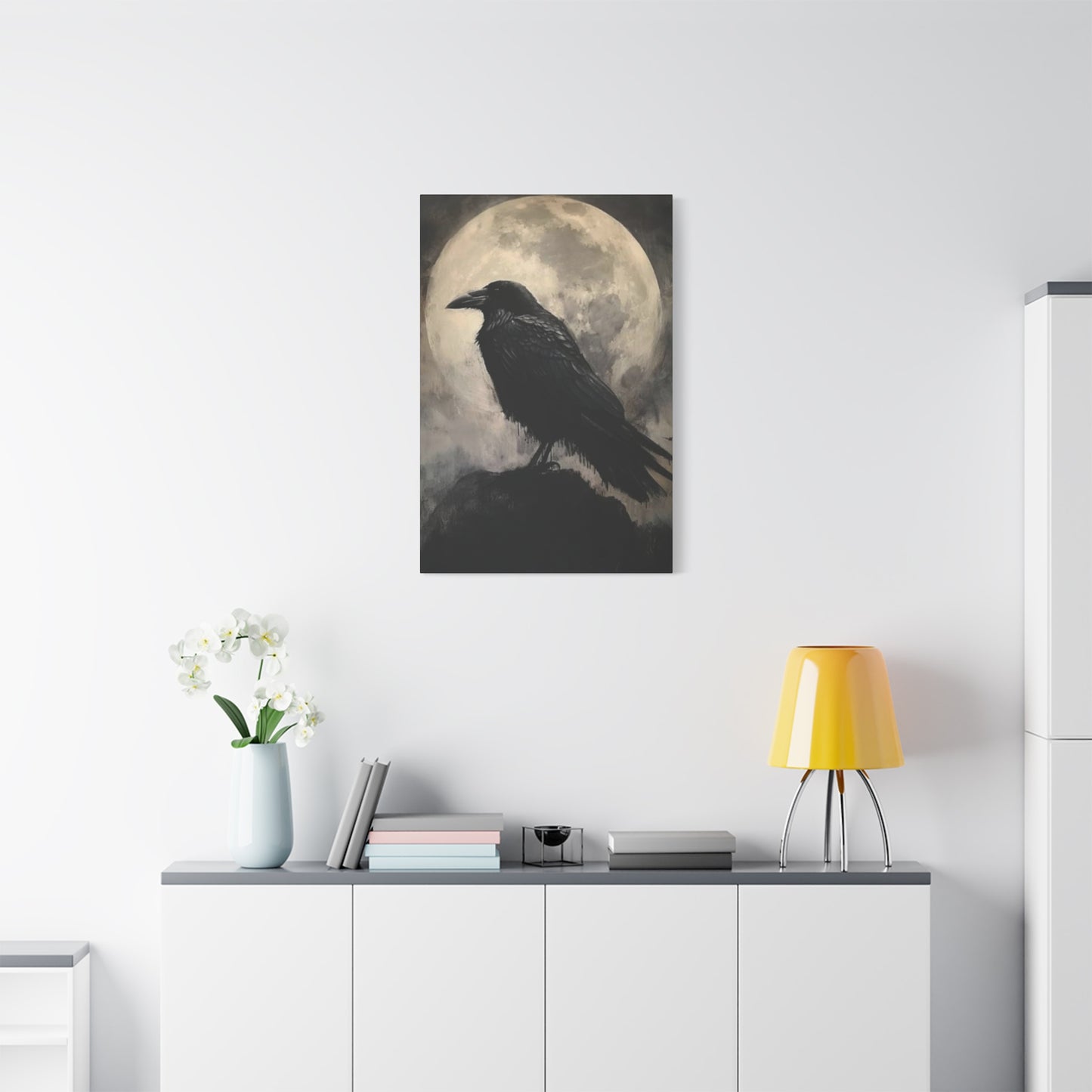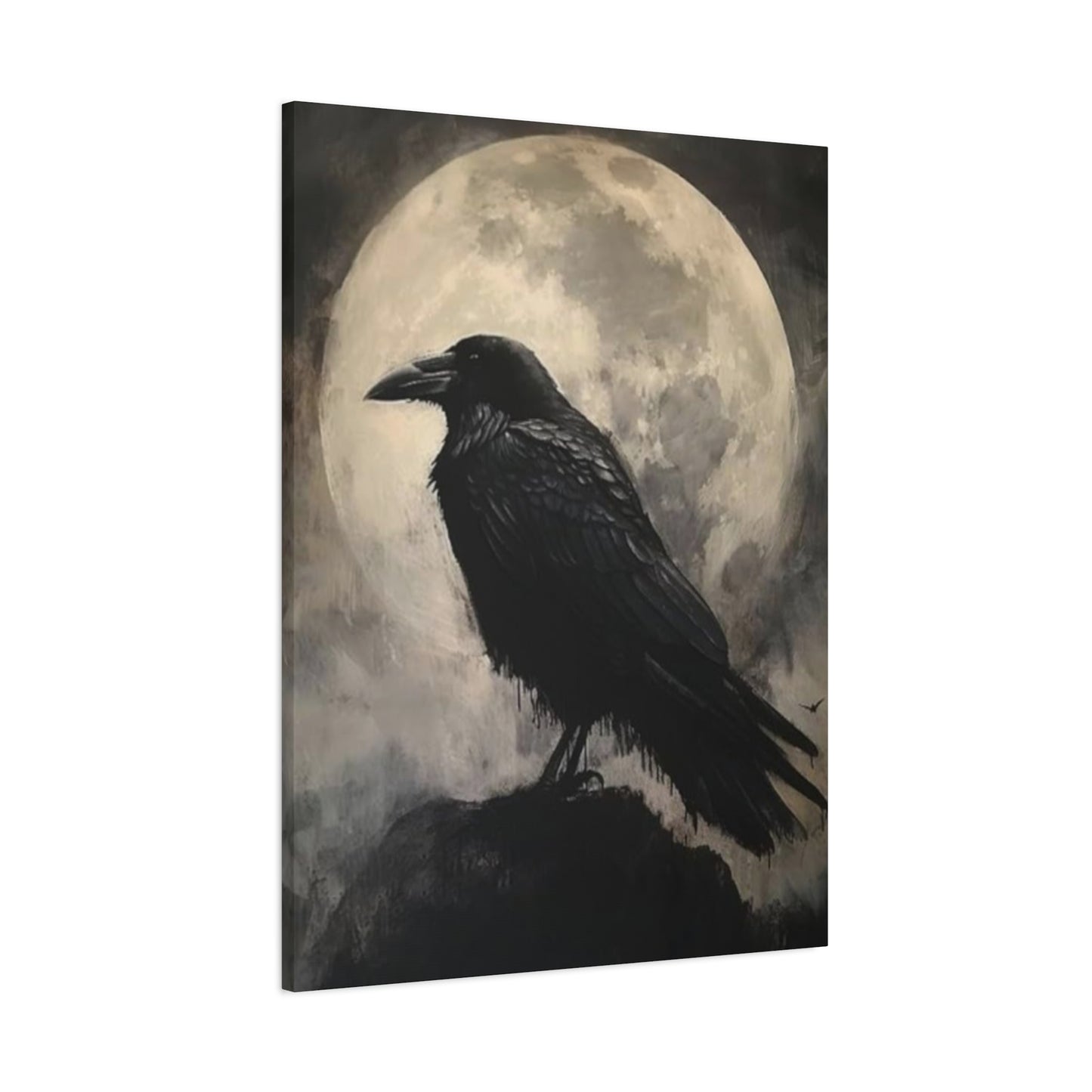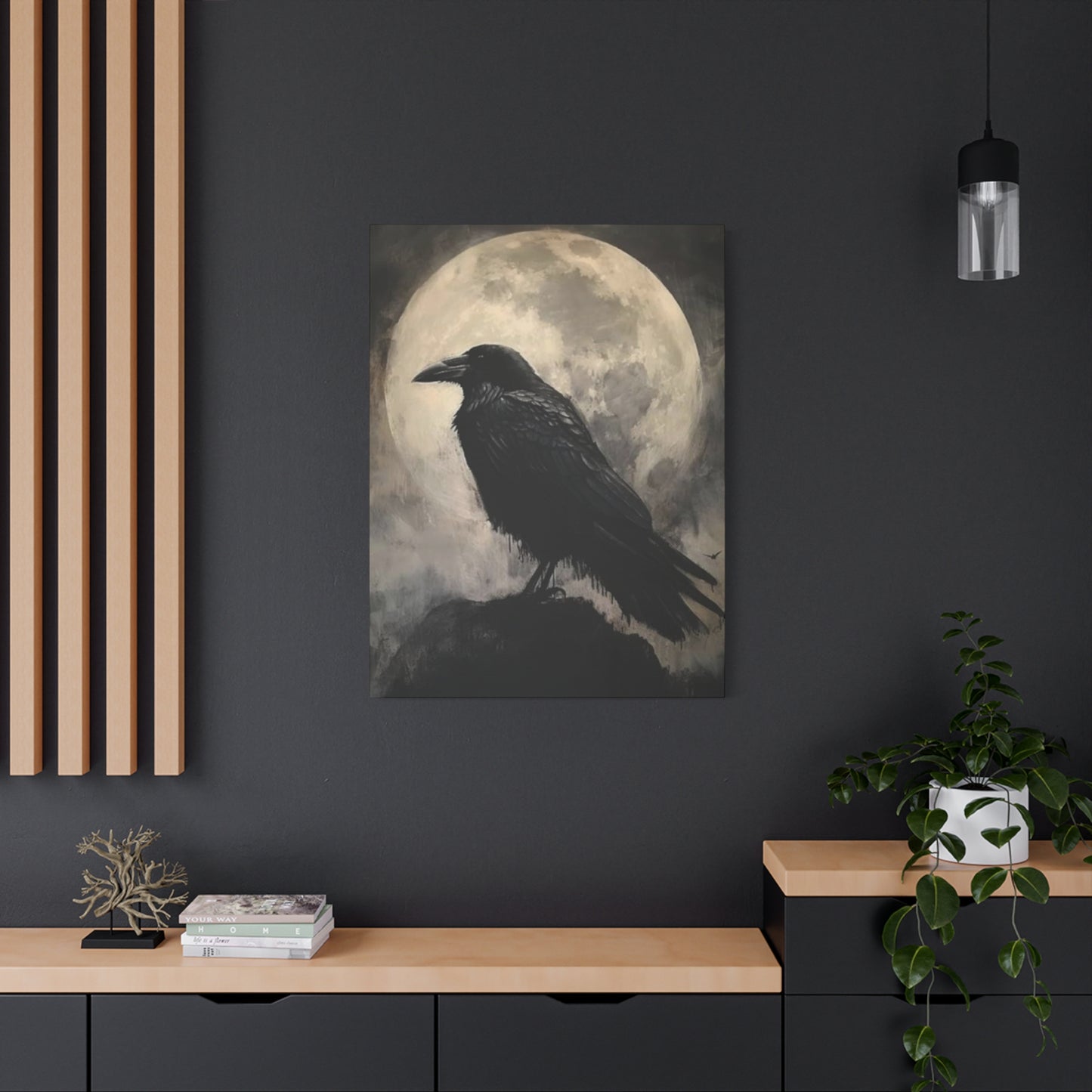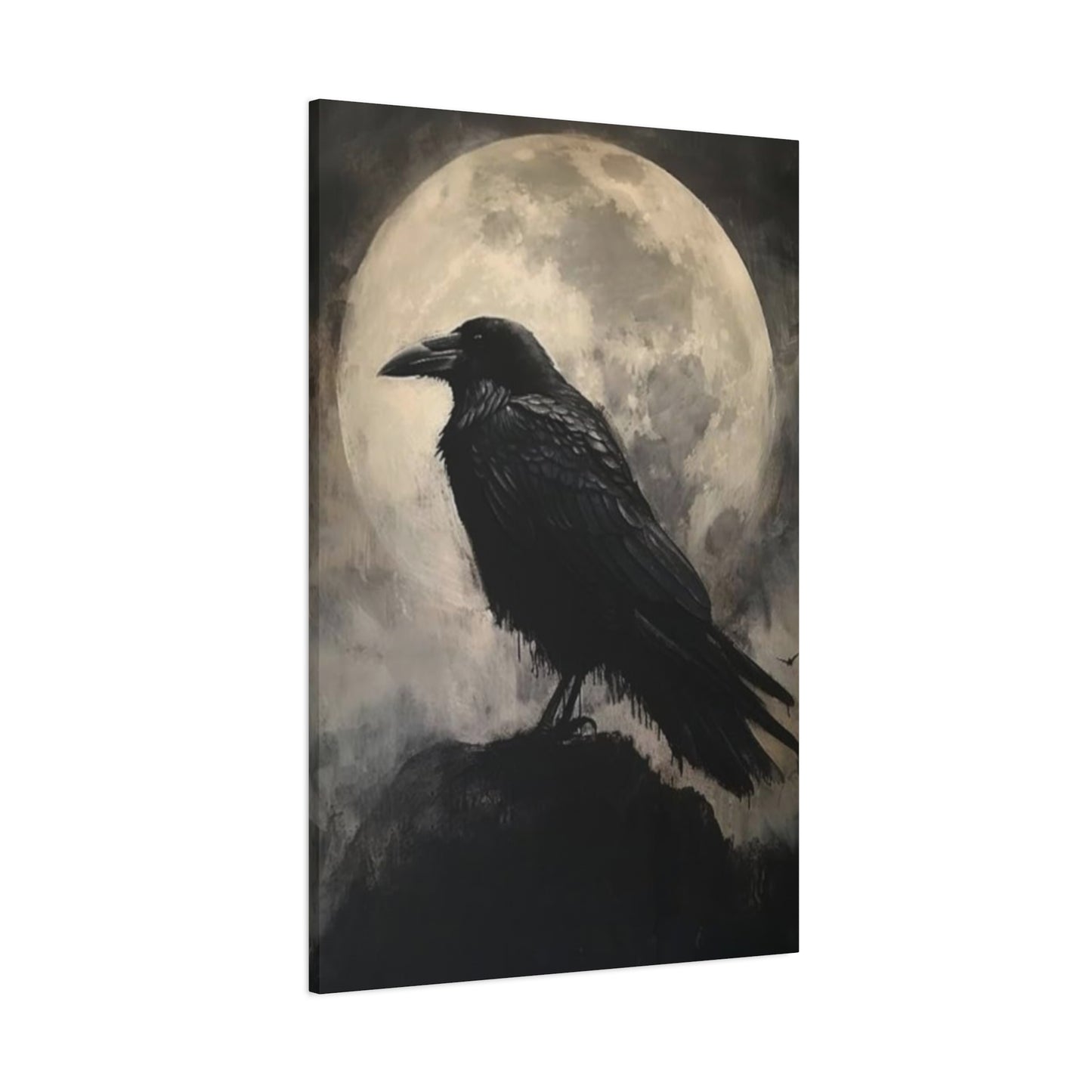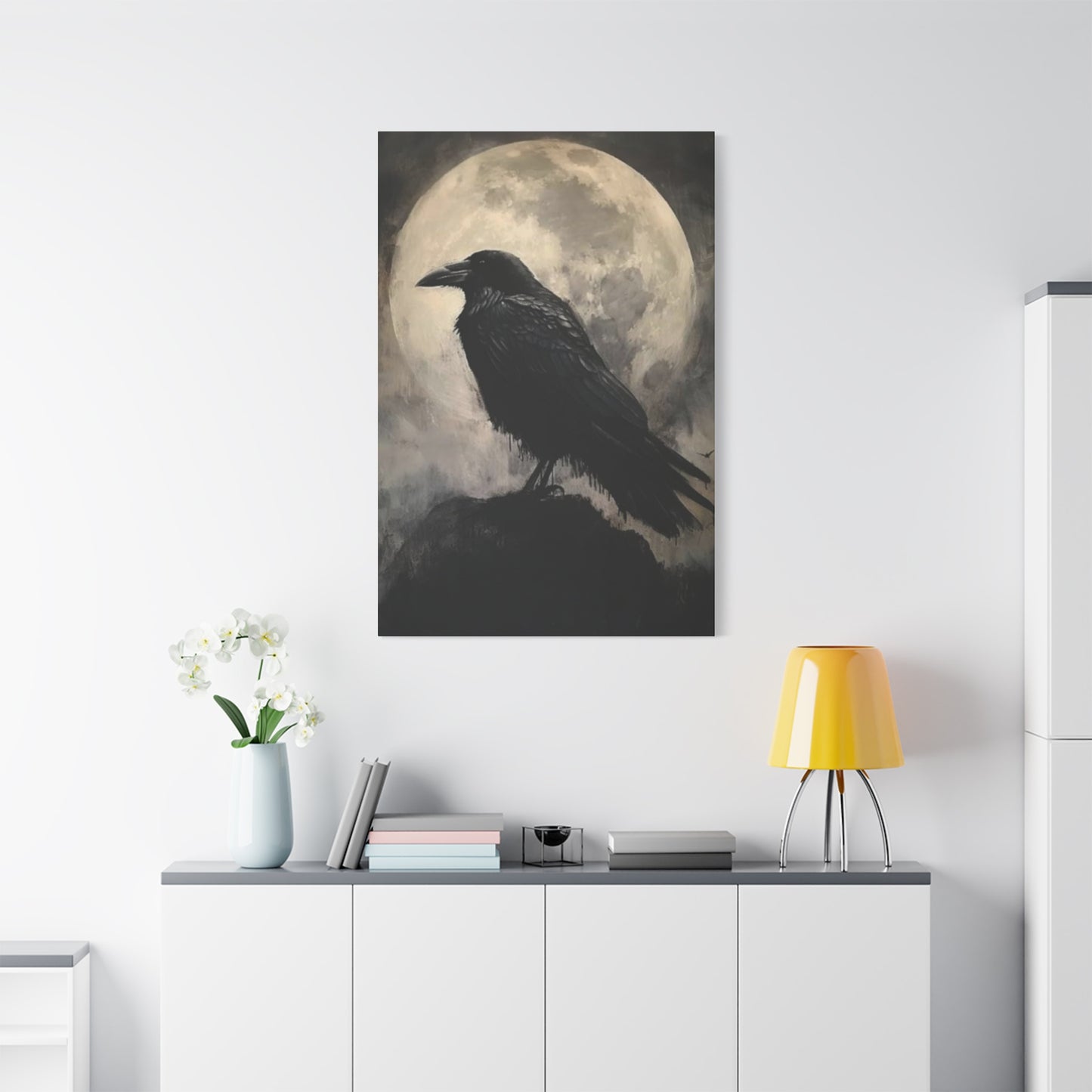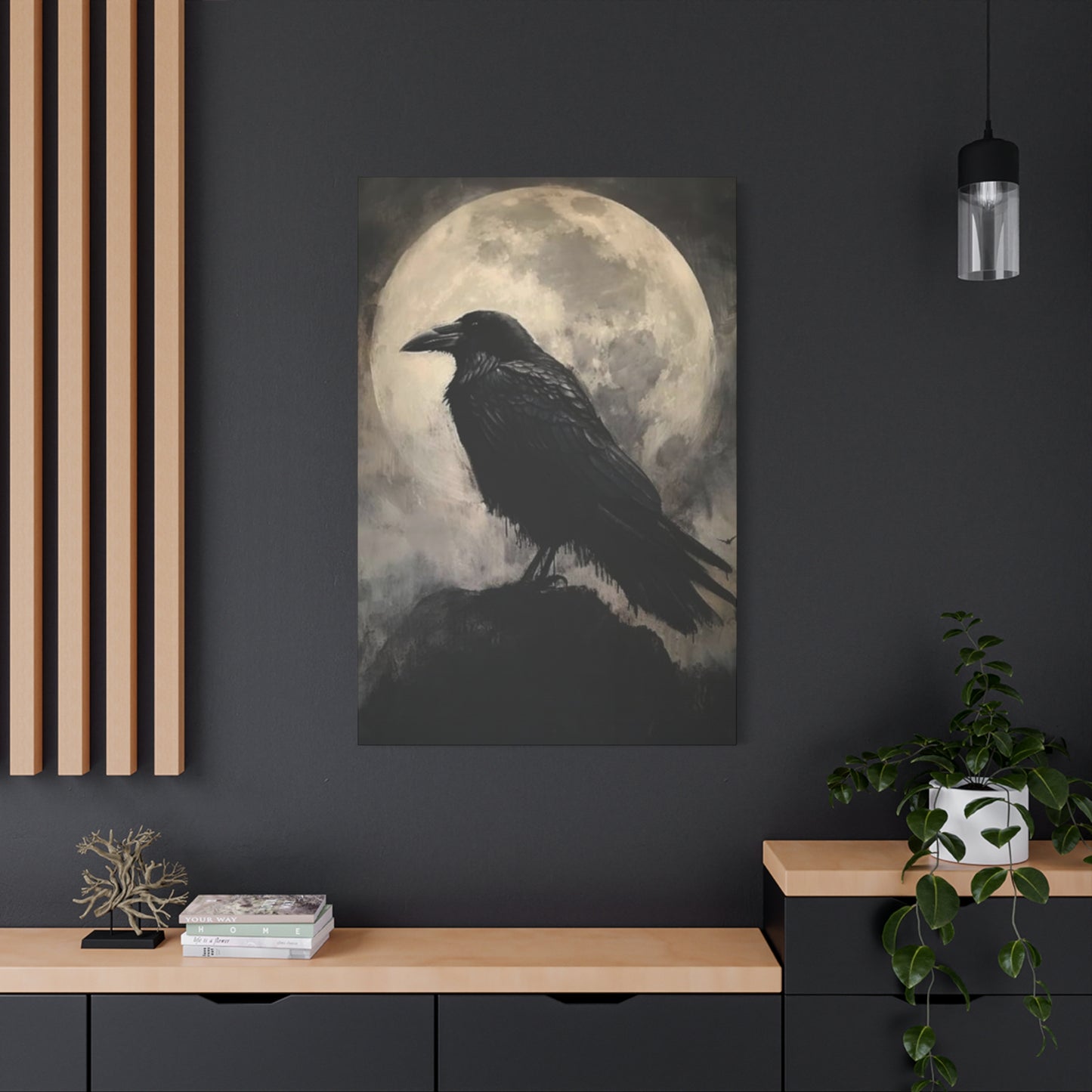Elevate Your Space with Mystical Crow and Full Moon Painting Wall Art
The enchanting combination of corvids and lunar imagery has captivated artists and art enthusiasts for centuries. This powerful pairing creates an atmosphere of mystery, wisdom, and natural beauty that transforms any living environment into a sanctuary of contemplation and aesthetic appeal. The marriage of these two elements produces artwork that speaks to our deepest connections with nature's cycles and the symbolic richness of both creatures and celestial bodies.
When we examine the artistic tradition surrounding these magnificent black birds beneath glowing orbs of light, we discover a wealth of cultural significance and visual impact that transcends mere decoration. These pieces serve as windows into our collective unconscious, bridging the gap between the earthly and the ethereal, the known and the mysterious. The visual dialogue between the dark silhouettes of these intelligent birds and the luminous presence of our planet's natural satellite creates compositions that are both striking and deeply meaningful.
Contemporary artists continue to explore this timeless theme, bringing fresh perspectives to ancient symbols while maintaining the essential mystery and beauty that makes this combination so compelling. Whether rendered in traditional oil paintings, modern digital prints, or mixed media installations, the crow and moon motif offers endless possibilities for creative expression and personal interpretation.
Full Moon Symbolism in Crow Art
The full moon carries profound symbolic weight across virtually every culture on Earth, representing cycles of renewal, feminine energy, intuition, and the passage of time. When paired with crow imagery, these meanings become amplified and take on additional layers of significance that speak to transformation and wisdom. The circular perfection of the full moon serves as a counterpoint to the organic, angular forms of corvids, creating visual tension that draws the eye and engages the imagination.
In many artistic traditions, the full moon represents completion and fulfillment, the culmination of a cycle that begins anew with each lunar month. This symbolism resonates deeply when combined with crow imagery, as these birds are often associated with messages from beyond, spiritual guidance, and the ability to navigate between different realms of existence. The full moon illuminates the darkness, revealing truths that might otherwise remain hidden, much like the crow's role as a revealer of secrets and harbinger of change.
Artists working with this symbolism often emphasize the moon's role as a source of illumination, using techniques that create dramatic contrasts between light and shadow. The full moon becomes not just a compositional element but a narrative device, suggesting stories of nocturnal journeys, spiritual awakening, and the eternal dance between opposing forces. The brightness of the lunar disc against the dark night sky mirrors the stark contrast between the crow's black plumage and the silvery light that bathes the nocturnal landscape.
The psychological impact of full moon symbolism in crow art cannot be understated. Viewers often report feeling a sense of mystery, contemplation, and connection to natural rhythms when encountering these works. The full moon serves as a universal symbol that transcends cultural boundaries, speaking to shared human experiences of wonder, introspection, and our relationship with cosmic cycles that have guided civilizations throughout history.
Contemporary interpretations of full moon symbolism in crow art often incorporate modern understanding of lunar influences on natural phenomena, from tidal movements to animal behavior patterns. This scientific awareness adds depth to traditional symbolic interpretations, creating artwork that speaks to both ancient wisdom and contemporary knowledge. Artists may reference the moon's gravitational effects, its role in navigation, or its influence on nocturnal creatures, weaving these elements into compositions that honor both mythology and natural science.
The meditative quality of full moon imagery combined with crow symbolism creates artwork that functions as more than mere decoration. These pieces become focal points for contemplation, meditation, and personal reflection, serving as visual anchors that help viewers connect with deeper aspects of their own nature and their relationship to the natural world around them.
Crow Silhouettes Under the Moon
The artistic technique of creating crow silhouettes against lunar backgrounds represents one of the most powerful and immediately recognizable approaches to this subject matter. The stark contrast between the bird's dark form and the moon's luminous presence creates dramatic visual impact that captures attention and holds it, drawing viewers into a world of mystery and natural beauty. This approach strips away unnecessary details, focusing on essential forms that speak directly to the viewer's imagination and emotional response.
Silhouette work requires exceptional skill in capturing the essence of corvid anatomy and posture. Artists must understand how these birds move, perch, and fly to create convincing forms that maintain their grace and power even when reduced to pure shadow. The angle of the head, the spread of wing feathers, the curve of the beak, and the positioning of talons all contribute to creating believable and compelling silhouettes that read immediately as authentic representations of these magnificent creatures.
The moon's role in silhouette compositions extends beyond mere background element to become an active participant in the visual narrative. Artists often position the lunar disc to interact with the crow silhouettes in meaningful ways, perhaps partially obscured by a wing, reflected in an eye, or serving as a perch for the bird's feet. These interactions create layers of meaning and visual interest that reward careful observation and contemplation.
Lighting effects in crow silhouette art require careful consideration of how moonlight actually behaves in natural settings. Authentic moonlight is softer and more diffuse than artificial lighting, creating subtle gradations and gentle illumination that artists must capture to maintain believability. The way moonlight catches the edges of feathers, creates subtle rim lighting, or filters through wing membranes all contribute to the overall effectiveness of the silhouette approach.
Color palettes for silhouette work typically emphasize the contrast between deep blacks and silvery whites, but sophisticated artists introduce subtle variations that add depth and interest without compromising the essential simplicity of the approach. Hints of deep blue, purple, or warm gray can suggest atmospheric conditions, time of night, or seasonal variations while maintaining the powerful contrast that makes silhouette work so effective.
The emotional impact of crow silhouettes under the moon often relates to themes of solitude, contemplation, and connection with natural rhythms. These images can evoke feelings of peace, mystery, or even mild melancholy that many viewers find deeply satisfying and conducive to introspection. The simplicity of the silhouette approach allows each viewer to project their own interpretations and emotional responses onto the artwork, making it a highly personal experience despite its universal appeal.
Nighttime Mood in Wall Paintings
Creating authentic nighttime atmospheres in crow and moon artwork requires sophisticated understanding of how darkness affects color, contrast, and visual perception. Nighttime scenes possess unique qualities that distinguish them from mere darkened versions of daylight compositions, and artists must master these subtleties to create convincing and emotionally resonant nocturnal artwork. The challenge lies in maintaining visual clarity and interest while honoring the reduced light conditions that define nighttime environments.
The psychology of nighttime imagery taps into deep human responses to darkness, quiet, and the mysterious qualities of nocturnal hours. These paintings often evoke feelings of calm introspection, spiritual connectivity, and heightened awareness that many people associate with nighttime experiences. The reduced visual stimulation of nighttime scenes can actually increase the impact of key elements like the moon's glow or the dramatic form of a crow in flight.
Color temperature becomes crucial in nighttime mood paintings, as artificial lighting often appears warmer while moonlight tends toward cooler tones. Artists must balance these different light sources to create believable environments while maintaining visual harmony throughout the composition. The interplay between warm and cool tones can suggest time of night, season, or atmospheric conditions that add depth and authenticity to the overall mood.
Atmospheric perspective takes on special importance in nighttime scenes, as darkness naturally obscures distant elements and creates layers of visual depth through graduated tonal values. Artists working with crow and moon subjects can use these principles to suggest vast landscapes, intimate settings, or mysterious environments that extend beyond the visible boundaries of the artwork. The way fog, mist, or simple distance affects visibility becomes a powerful compositional tool.
Texture and brushwork in nighttime mood paintings often emphasize softness and subtlety over sharp definition, reflecting the way darkness naturally softens edges and reduces contrast. However, key elements like the moon's surface or the outline of a crow might be rendered with greater precision to create focal points and maintain visual interest. This selective approach to detail helps guide the viewer's attention while maintaining the overall nighttime atmosphere.
The symbolic associations of nighttime imagery enhance the mystical qualities already present in crow and moon subjects. Nighttime represents the realm of dreams, intuition, and subconscious exploration, making it the perfect setting for artwork that seeks to connect with deeper psychological and spiritual themes. These paintings become windows into the nocturnal world, inviting viewers to explore the beauty and mystery of hours when most human activity ceases and nature reveals different aspects of its character.
Dark vs. Light in Moon Crow Art
The fundamental contrast between dark and light elements forms the visual foundation of compelling crow and moon artwork, creating dramatic tension that captures attention and communicates powerful symbolic meanings. This interplay between opposing forces reflects universal themes found throughout art history, from religious paintings to contemporary abstract works, making it a time-tested approach for creating visually striking and emotionally resonant compositions.
Understanding how to balance dark and light elements requires careful consideration of visual weight, contrast ratios, and the way human eyes process different tonal values. Dark areas tend to recede while light areas advance, creating natural depth and dimensionality that artists can exploit to guide viewer attention and create compelling visual journeys through the composition. The crow's dark form against the moon's bright disc exemplifies this principle in its most basic and effective form.
The symbolic implications of dark versus light in this context extend far beyond mere visual contrast to encompass themes of knowledge versus ignorance, mystery versus revelation, and the eternal struggle between opposing cosmic forces. Crows, with their association with wisdom and magic, represent the positive aspects of darkness, while the moon embodies illumination and guidance. This creates a complex symbolic relationship that goes beyond simple opposition to suggest complementary forces working in harmony.
Technical approaches to achieving effective dark and light contrast vary widely among artists and media. Oil painters might build up deep shadows with multiple layers of transparent glazes while reserving bright highlights for key areas. Watercolorists might rely on the white of the paper to create luminous moon effects while building darker tones through successive washes. Digital artists have unprecedented control over contrast ratios and can create effects that might be impossible with traditional media.
Color relationships become particularly important when working with strong dark and light contrasts, as pure black and white can appear harsh and artificial without careful consideration of the surrounding color environment. Subtle color variations within dark areas can suggest depth, texture, and atmospheric effects, while the bright areas might incorporate slight color casts that suggest different light sources or atmospheric conditions.
The emotional impact of strong dark and light contrasts often creates feelings of drama, mystery, and heightened awareness that perfectly complement the symbolic content of crow and moon imagery. These compositions demand attention and create memorable visual experiences that linger in the viewer's mind long after the initial encounter. The stark beauty of this approach appeals to fundamental human responses to light and darkness that transcend cultural boundaries and speak to universal experiences of day and night, known and unknown, revealed and hidden.
Mystical Crow and Moon Scenes
The mystical aspects of crow and moon imagery tap into ancient spiritual traditions and contemporary New Age spirituality, creating artwork that functions as both aesthetic objects and tools for meditation and spiritual exploration. These scenes often incorporate symbolic elements that reference various mystical traditions, from Celtic mythology to Native American spirituality, creating rich tapestries of meaning that reward careful study and contemplation.
Sacred geometry often appears in mystical crow and moon artwork, with artists incorporating circles, spirals, and other meaningful shapes that suggest cosmic order and spiritual significance. The moon itself represents perfect circular form, while the crow's flight path might trace symbolic patterns or the composition might include subtle geometric elements that add layers of meaning for viewers familiar with esoteric symbolism.
The concept of liminal moments—those threshold times when ordinary reality becomes permeable to spiritual insights—frequently influences mystical crow and moon scenes. Artists might depict twilight hours, seasonal transitions, or moments of profound stillness when the veil between worlds seems thinnest. These temporal choices enhance the mystical atmosphere and suggest that the artwork captures moments of special spiritual significance.
Archetypal symbolism plays a crucial role in mystical interpretations of this subject matter, drawing on Carl Jung's concept of universal symbols that resonate across cultures and individuals. The crow as messenger, the moon as divine feminine, and their combination as representing the balance between earthly wisdom and celestial guidance create powerful archetypal imagery that speaks to deep psychological patterns.
Energy and movement in mystical scenes often suggest invisible forces at work, whether through the implied motion of crow wings, the subtle emanation of moonlight, or the inclusion of abstract elements that suggest spiritual energies. Artists might use flowing lines, subtle color gradations, or compositional rhythms that imply movement beyond the purely physical realm.
Contemporary mystical crow and moon artwork often incorporates elements from various spiritual traditions while creating new synthetic approaches that speak to modern seekers. These pieces might combine Eastern concepts of energy flow with Western magical symbolism, Native American animal spirit traditions with contemporary environmental consciousness, creating artwork that functions as spiritual tools while maintaining high aesthetic standards and emotional appeal for viewers regardless of their spiritual beliefs.
Full Moon Glow Techniques
Mastering the visual representation of moonlight's unique qualities requires understanding how this reflected solar illumination behaves differently from direct light sources. Moonlight possesses distinctive characteristics—cooler color temperature, softer intensity, and more diffuse distribution—that artists must accurately capture to create convincing and atmospheric crow and moon compositions. The technical challenges of depicting authentic moonlight effects have inspired countless artistic innovations throughout history.
Layering techniques prove essential for building convincing moon glow effects, particularly in traditional painting media. Artists often begin with subtle undertones that suggest the moon's presence, gradually building intensity through successive layers of increasingly opaque paint. This approach allows for careful control of luminosity while maintaining the soft, diffused quality that distinguishes moonlight from harsher artificial light sources.
Color mixing for moonlight effects requires sophisticated understanding of how different pigments interact to create the subtle blues, violets, and silvers associated with lunar illumination. Pure white rarely appears in authentic moonlight scenes; instead, artists must develop palettes that suggest the cool, ethereal quality of reflected sunlight filtered through Earth's atmosphere. The interaction between these cool moon tones and the warm darks used for crow silhouettes creates compelling color relationships.
Atmospheric effects play crucial roles in convincing moon glow depictions, as Earth's atmosphere scatters and filters moonlight in ways that affect its appearance and distribution. Artists might suggest humidity, dust, or temperature variations through subtle modifications to the moon's appearance and the way its light interacts with surrounding elements. These atmospheric considerations add authenticity and depth to the overall composition.
Digital techniques for creating moon glow effects offer unprecedented control over luminosity, color temperature, and distribution patterns. Artists can experiment with layer blending modes, gradient tools, and filter effects to achieve results that might be difficult or impossible with traditional media. However, the best digital artists understand traditional moonlight principles and use technology to enhance rather than replace fundamental artistic knowledge.
The integration of moon glow with crow subjects requires careful attention to how the light would actually interact with the bird's form and feathers. Rim lighting, reflected light, and cast shadows must all be considered to maintain believability while creating visually striking effects. The way moonlight might catch the edge of a wing, illuminate an eye, or create subtle texture variations in black feathers adds realism and visual interest to the composition.
Gothic Full Moon Crow Decor
Gothic aesthetic principles find perfect expression in crow and moon imagery, combining the dramatic contrasts, mysterious atmospheres, and symbolic richness that define this enduring artistic movement. Gothic full moon crow artwork embraces darkness not as something to be feared but as a source of beauty, contemplation, and spiritual insight, creating pieces that function as both decorative elements and expressions of philosophical outlook.
Architectural elements frequently appear in Gothic crow and moon compositions, referencing the great cathedrals, castles, and monuments associated with the Gothic tradition. These structures provide dramatic silhouettes against moonlit skies while suggesting themes of permanence, spirituality, and human achievement in the face of mortality. The vertical lines of Gothic architecture create dynamic compositions that complement the organic forms of crows and the circular perfection of the moon.
Color palettes in Gothic crow and moon artwork typically emphasize deep, rich tones that suggest luxury, mystery, and sophistication. Deep purples, midnight blues, and burgundy reds might accompany the expected blacks and silvers, creating environments that feel both elegant and slightly foreboding. These color choices reflect the Gothic movement's embrace of beauty found in darkness and its rejection of purely optimistic worldviews.
Symbolic elements drawn from Gothic tradition—roses, thorns, crosses, and ornate decorative details—often find their way into contemporary Gothic crow and moon artwork. These elements add layers of meaning and visual interest while connecting the work to a rich artistic heritage that spans centuries. The interplay between Christian symbolism and pagan natural imagery creates complex narratives that reward careful study.
Texture and surface treatment in Gothic styles often emphasize richness and tactile appeal, whether through impasto paint techniques, elaborate frames, or mixed media approaches that incorporate actual materials like metal, stone, or fabric. These textural elements enhance the sensual appeal of the artwork while suggesting the materiality and craftsmanship associated with Gothic artistic traditions.
The psychological appeal of Gothic crow and moon decor often relates to its ability to acknowledge and beautify aspects of human experience that other artistic approaches might avoid or minimize. Death, mystery, solitude, and contemplation of eternal themes find expression in these works, creating artwork that provides emotional outlets for viewers who appreciate beauty found in darkness and complexity rather than simple optimism.
Minimalist Crow Moon Designs
The minimalist approach to crow and moon artwork strips away non-essential elements to focus on pure form, essential relationships, and maximum visual impact through minimal means. This aesthetic philosophy, rooted in mid-20th century art movements, brings fresh perspectives to ancient symbolic relationships by eliminating distractions and concentrating on fundamental visual and emotional truths.
Compositional economy becomes paramount in minimalist crow moon designs, with every element serving multiple purposes and no space wasted on decorative details that don't contribute to the overall impact. A single crow silhouette against a simple moon form might convey more emotional power than elaborate compositions filled with extraneous details. This approach requires exceptional skill in understanding what elements are truly essential to the intended effect.
Negative space assumes equal importance with positive forms in minimalist approaches, as the empty areas of the composition become active participants in the visual dialogue. The space between a crow and the moon, the emptiness surrounding these forms, and the relationship between occupied and unoccupied areas all contribute to the overall aesthetic impact. Masters of minimalist design understand how to make emptiness speak as eloquently as filled areas.
Limited color palettes in minimalist crow moon artwork often rely on monochromatic or near-monochromatic schemes that eliminate color as a distraction while focusing attention on form, contrast, and spatial relationships. Black, white, and subtle grays might constitute the entire palette, or a single accent color might be introduced for specific emotional or symbolic purposes. These constraints force artists to achieve maximum impact through non-chromatic means.
Scale relationships become crucial in minimalist compositions, as the relative sizes of elements communicate meaning without relying on detailed rendering or complex narratives. A tiny crow silhouette against an enormous moon suggests different themes than compositions where these proportions are reversed. These scaling decisions become primary tools for emotional and symbolic communication.
The meditative quality of minimalist crow moon designs often appeals to viewers seeking calm, contemplative artwork that doesn't overwhelm with visual complexity. These pieces function excellently in modern environments where clean lines and uncluttered aesthetics are valued, while still providing the symbolic richness and emotional resonance associated with this timeless subject matter. The apparent simplicity of minimalist approaches often conceals sophisticated understanding of visual principles and deep appreciation for the essential meanings embedded in these ancient symbols.
DIY Full Moon Crow Painting
Creating original crow and moon artwork provides deeply satisfying creative experiences while allowing for personal expression and interpretation of these timeless themes. The DIY approach enables artists at any skill level to explore this subject matter using readily available materials and techniques that can be adapted to individual preferences and capabilities. The process of creating these paintings often proves as meaningful as the finished artwork itself.
Material selection for DIY crow moon paintings depends on personal preferences, budget considerations, and desired outcomes. Acrylic paints offer excellent versatility, quick drying times, and easy cleanup, making them ideal for beginners or artists working in shared environments. Oil paints provide superior blending capabilities and longer working times but require more careful handling and ventilation. Watercolors create beautiful atmospheric effects but demand different technical approaches and offer less room for corrections.
Surface preparation plays crucial roles in achieving professional-looking results, regardless of the chosen medium. Canvas boards, stretched canvases, watercolor paper, or even alternative surfaces like wood panels each offer different characteristics that affect the final appearance of the artwork. Proper priming and preparation ensure paint adhesion and longevity while providing the best foundation for successful painting experiences.
Compositional planning helps ensure successful outcomes by establishing the basic relationships between elements before committing paint to surface. Simple thumbnail sketches can help determine the most effective placement of the moon, the positioning and scale of crow elements, and the overall balance of the composition. These preliminary studies also provide opportunities to experiment with different arrangements without wasting materials.
Color mixing techniques for DIY crow moon paintings involve understanding how to create convincing moonlight effects, rich shadow tones, and atmospheric colors that enhance the overall mood of the piece. Learning to mix cool grays for moonlight, warm darks for shadows, and subtle color variations that suggest depth and atmosphere enables artists to create convincing and visually appealing results with basic color palettes.
Step-by-step approaches to painting crow moon subjects typically begin with establishing the basic composition and major shapes, then gradually adding details and refinements. Working from general to specific allows for corrections and adjustments throughout the process while building up the painting in logical stages. Understanding when to stop adding details is often as important as knowing how to add them, particularly for beginners who might be tempted to overwork their paintings.
Moonlit Crow Flight Meaning
The symbolic significance of crows in flight beneath moonlight draws from diverse cultural traditions and personal interpretations that make this imagery particularly rich and meaningful for contemporary viewers. Flight itself represents freedom, transcendence, and the ability to move between different realms of existence, while the nocturnal setting adds layers of mystery and spiritual significance that deepen the overall symbolic impact of these compositions.
Mythological associations of crow flight vary widely across cultures, from Norse traditions where ravens served as messengers for Odin to Native American beliefs about corvids as creators and trickster figures. The addition of moonlight to flight imagery often suggests journeys between worlds, spiritual messages, or moments of transformation when ordinary reality becomes permeable to other dimensions of experience.
Psychological interpretations of moonlit crow flight often relate to themes of personal transformation, intuitive insights, and the courage required to navigate uncertain territories. The combination of flight and darkness can represent the willingness to venture into unknown psychological or spiritual realms, trusting in inner wisdom rather than relying solely on rational understanding. These images often resonate with viewers undergoing personal transitions or spiritual seeking.
Seasonal and temporal associations add additional layers of meaning to moonlit crow flight imagery, as different times of year and night create different symbolic contexts. Autumn crow flights might suggest preparation for winter's challenges, while spring flights could represent renewal and new beginnings. The specific phase of the moon—full, crescent, or new—also contributes to the overall symbolic meaning of the composition.
Directional symbolism in crow flight scenes can communicate different meanings depending on the implied direction of movement. Eastward flights might suggest new beginnings and dawn approaching, while westward journeys could represent completion and evening reflections. Upward movements often suggest spiritual aspiration, while earthward flights might indicate returning to practical concerns or grounding spiritual insights in daily life.
Contemporary interpretations of moonlit crow flight meaning often incorporate environmental awareness, urban-rural relationships, and modern spiritual seeking into traditional symbolic frameworks. These images might represent the desire to reconnect with natural rhythms in increasingly urbanized environments, or the search for authentic spiritual experiences in secular societies. The enduring appeal of this imagery suggests its continued relevance for addressing contemporary human needs and aspirations.
Metallic Paint for Moonlight
The use of metallic paints and pigments in crow and moon artwork offers unique opportunities to create luminous effects that capture the ethereal quality of moonlight while adding textural interest and visual sophistication to compositions. These specialized materials interact with light in ways that conventional pigments cannot match, creating surfaces that seem to glow from within and respond dynamically to changing viewing conditions.
Silver pigments and paints provide the most obvious choices for moonlight effects, offering the cool, reflective qualities associated with lunar illumination. However, sophisticated artists often employ subtle variations of metallic tones—pale gold, platinum, or iridescent white—to suggest different atmospheric conditions, seasonal variations, or specific emotional moods within their compositions. The key lies in selecting metallics that enhance rather than overwhelm the overall aesthetic.
Application techniques for metallic paints require different approaches than conventional pigments, as these materials often behave differently in terms of consistency, drying time, and blending characteristics. Some metallic paints are best applied in single, confident strokes to maintain their reflective properties, while others can be worked and blended like traditional colors. Understanding these material properties is essential for achieving desired effects.
Layering metallic effects with conventional paints allows for sophisticated interplay between reflective and matte surfaces that can create compelling visual contrasts and depth. Artists might apply metallic highlights over conventional base colors, or use metallic glazes to suggest atmospheric effects that enhance the overall moonlight ambiance. These layering techniques require careful attention to compatibility between different paint systems.
Texture integration with metallic paints opens additional creative possibilities, as these materials can be applied with various tools and techniques to create surface variations that catch and reflect light in interesting ways. Brush textures, palette knife applications, or even unconventional tools like sponges or fabric can create surface variations that enhance the magical quality of moonlight effects.
Preservation and longevity considerations become important when working with metallic paints, as some formulations may tarnish or change color over time if not properly protected. Understanding the archival qualities of different metallic materials and appropriate varnishing or protective techniques ensures that artwork maintains its intended appearance over time. Professional-grade metallics generally offer better stability and longevity than craft-grade alternatives.
Autumn Vibes with Crow Art
The convergence of autumn themes with crow and moon imagery creates particularly evocative artwork that captures the melancholic beauty and reflective mood associated with seasonal transition. Autumn represents a time of preparation, harvest, and contemplation of life cycles that perfectly complements the symbolic richness of corvid and lunar subjects. This seasonal context adds layers of meaning and emotional resonance that appeal to viewers' connections with natural rhythms.
Color palettes for autumn crow and moon artwork typically incorporate the warm earth tones associated with fall foliage while maintaining the cool tones necessary for authentic moonlight effects. Burnt oranges, deep yellows, rich browns, and burgundy reds might appear in background elements, foliage, or atmospheric effects while the primary subjects maintain their characteristic color relationships. This warm-cool contrast creates visually dynamic compositions with strong seasonal identification.
Atmospheric effects unique to autumn—morning mists, changing light quality, and the particular clarity of fall air—provide additional elements that enhance the seasonal character of these compositions. Artists might suggest the crisp quality of autumn air through sharper contrast relationships, or the haziness of Indian summer through softer, more diffused effects. These atmospheric considerations contribute significantly to the overall seasonal authenticity.
Symbolic associations of autumn with themes of maturity, wisdom, preparation, and reflection align naturally with the traditional meanings of crow imagery. The harvest season suggests gathering wisdom and resources for coming challenges, while the approaching winter mirrors the introspective qualities often associated with corvid symbolism. These thematic connections create coherent symbolic narratives that resonate with viewers' seasonal experiences.
Compositional elements specific to autumn scenes might include falling leaves, bare branches, or landscape features that suggest the season without overwhelming the primary crow and moon subjects. These seasonal indicators provide context and atmosphere while supporting rather than competing with the main subjects. The challenge lies in integrating seasonal elements in ways that enhance rather than clutter the overall composition.
The emotional appeal of autumn crow and moon artwork often relates to nostalgia, contemplation of life passages, and appreciation for the bittersweet beauty found in endings that promise new beginnings. These themes resonate strongly with viewers experiencing their own life transitions or seasonal mood shifts. The artwork provides visual anchors for seasonal emotions while offering the timeless comfort found in natural cycles and their artistic representation.
Crow and Moon in Folklore
Folklore traditions from around the world have woven together crow and moon imagery in stories that reveal deep cultural understanding of these symbols' psychological and spiritual significance. These traditional narratives provide rich sources of inspiration for contemporary artists while connecting modern viewers to ancient wisdom traditions that recognized the profound meanings embedded in natural phenomena and animal behavior.
Celtic folklore presents particularly rich traditions involving both crows and lunar symbolism, with stories of the Morrigan—the phantom queen who often appeared as a crow—and her connections to lunar cycles, prophecy, and the mysteries of life and death. These traditions view crows as messengers between worlds, while the moon represents the goddess aspect of divine feminine energy. The combination suggests powerful spiritual forces operating beyond ordinary human understanding.
Native American traditions offer diverse perspectives on crow and moon relationships, varying among different tribal cultures but generally recognizing corvids as intelligent, adaptable creatures with special roles in creation stories and spiritual guidance. Lunar symbolism in these traditions often relates to timekeeping, agricultural cycles, and feminine wisdom, creating contexts where crow and moon imagery represents the intersection of practical knowledge and spiritual insight.
Norse mythology includes extensive crow and raven lore, with Huginn and Muninn serving as Odin's messengers and scouts who brought him knowledge from all nine realms. The addition of lunar imagery to these traditions often suggests journeys through different realms of existence, particularly the nighttime travels that brought information from the world of dreams and spirit. These stories provide frameworks for understanding crow and moon art as representing the quest for knowledge and wisdom.
Asian folklore traditions, particularly from China and Japan, include numerous stories involving crows and lunar imagery that often focus on transformation, loyalty, and the relationship between earthly and celestial realms. The three-legged crow of Chinese mythology lives in the sun, while lunar symbolism represents yin energy, creating complementary rather than competitive relationships between these cosmic forces. These traditions inform artistic approaches that emphasize balance and harmony rather than conflict.
Contemporary folklore continues to evolve around crow and moon imagery, particularly in urban legends, modern pagan traditions, and popular culture interpretations that blend ancient wisdom with current concerns. These modern folklore elements often address environmental themes, spiritual seeking in secular societies, and the desire to reconnect with natural rhythms in increasingly artificial environments. Artists drawing from these contemporary folklore sources create artwork that speaks to current cultural needs while honoring traditional symbolic meanings.
Contrast in Night Wall Art
The effective use of contrast principles in nocturnal artwork requires sophisticated understanding of how human visual perception operates under different lighting conditions and how these principles can be manipulated for maximum artistic impact. Night scenes present unique challenges and opportunities for creating compelling contrast relationships that guide viewer attention while maintaining the authentic atmospheric qualities that define convincing nocturnal imagery.
Tonal contrast becomes particularly crucial in night artwork, as the reduced overall light levels compress the available value range and force artists to work within narrower parameters while still maintaining visual clarity and interest. The relationship between the darkest darks and the brightest lights in crow and moon compositions must be carefully calibrated to suggest authentic nighttime conditions while providing sufficient contrast to maintain viewer engagement and compositional clarity.
Color contrast in night wall art often relies on temperature relationships rather than value differences, as warm and cool color interactions become more important when overall values are compressed into darker ranges. The cool blues and violets of nighttime shadows contrast with the warm yellows and oranges of artificial light sources, while moonlight provides cool illumination that creates subtle but important color relationships with surrounding darkness.
Texture contrast adds another layer of visual interest to night artwork, as the interplay between smooth and rough surfaces, sharp and soft edges, and detailed and simplified areas helps create depth and visual hierarchy within the limited value range of nocturnal scenes. The smooth glow of moonlight against the detailed texture of crow feathers exemplifies this principle in its most basic and effective form.
Scale contrast in night compositions can create dramatic effects by juxtaposing elements of vastly different sizes, such as small crow silhouettes against enormous moon discs or intimate foreground details against vast background landscapes. These scale relationships help establish depth, suggest narrative content, and create emotional responses that enhance the overall impact of the artwork.
Edge contrast—the relationship between hard and soft edges throughout the composition—becomes particularly important in night artwork where atmospheric effects naturally soften distant elements while closer subjects might maintain sharper definition. This selective use of edge contrast helps create depth, focus attention on key elements, and maintain the atmospheric authenticity that makes night scenes convincing and emotionally engaging for viewers.
Framing Moon Crow Paintings
The presentation of crow and moon artwork through appropriate framing choices significantly affects viewer perception and can either enhance or diminish the artwork's impact and meaning. Framing decisions involve considerations of style, color, proportion, and material that must complement the artwork's aesthetic while providing appropriate protection and presentation enhancement. These choices become particularly important for artwork with strong symbolic content that benefits from thoughtful presentation approaches.
Traditional framing approaches for crow and moon artwork often emphasize classic materials and profiles that honor the timeless nature of these subjects without competing for visual attention. Natural wood frames in darker tones complement the nocturnal themes while providing warm contrast to cool moonlight effects. Metal frames in silver, pewter, or dark bronze can echo the metallic qualities of moonlight while maintaining sophisticated, gallery-appropriate presentations.
Contemporary framing options allow for more experimental approaches that might incorporate unusual materials, asymmetrical designs, or mixed media elements that extend the artwork's themes into the framing itself. However, these approaches require careful consideration to ensure that framing enhancements support rather than overwhelm the central imagery. The goal remains directing attention to the artwork while providing appropriate contextual support.
Color relationships between frames and artwork require careful attention to ensure harmony without creating visual competition. Neutral colors typically provide safe choices that allow the artwork to dominate, but selective use of color in framing can enhance specific elements of the composition or reinforce particular mood qualities. The key lies in understanding which approach best serves the specific artwork and intended display environment.
Matting considerations for crow and moon artwork involve decisions about color, texture, and proportion that affect the transition between artwork and frame while providing additional protection and visual breathing room. Multiple mats can create sophisticated layering effects that enhance the artwork's presentation while neutral mat colors typically provide safe choices that won't interfere with the artwork's color relationships.
Environmental considerations affect framing choices, as different display locations require different approaches to protection, lighting, and visual integration with surrounding elements. Artwork intended for meditation rooms might benefit from simpler, less distracting framing, while pieces designed for dramatic architectural settings might require more substantial frames that can hold their own in complex visual environments. Understanding the intended display context helps inform appropriate framing decisions.
Meditation with Moon Crow Art
The contemplative qualities inherent in crow and moon imagery make these artworks particularly suitable for meditation practices and mindfulness exercises that benefit from visual focal points with rich symbolic content. The combination of natural beauty, symbolic depth, and aesthetic appeal creates ideal conditions for sustained attention and inner exploration that characterizes effective meditation support tools.
Visual meditation techniques using crow and moon artwork often begin with simple observation practices that gradually deepen into more profound contemplative states. Practitioners might begin by noticing obvious elements—the moon's brightness, the crow's form, the contrast relationships—before moving to more subtle aspects like implied movement, emotional qualities, or personal associations triggered by the imagery. This progressive approach allows for both beginning and advanced practitioners to benefit from the same artwork.
Symbolic meditation approaches utilize the rich mythological and psychological associations of crows and lunar imagery as springboards for inner exploration and insight development. Practitioners might contemplate themes of wisdom, transformation, cycles of change, or the relationship between conscious and unconscious aspects of experience. The artwork serves as a launching point for personal reflection rather than mere aesthetic appreciation.
Conclusion
Incorporating mystical crow and full moon paintings into your home decor offers a powerful way to elevate your space with symbolism, mystery, and artistic beauty. These two evocative images—the crow, often seen as a messenger between worlds, and the full moon, a symbol of intuition and transformation—combine to create artwork that is both visually striking and deeply meaningful. Together, they invite an atmosphere of introspection, magic, and connection to the unseen forces that influence our lives.
Crow imagery has long been associated with wisdom, change, and spiritual guidance. Revered in many cultures as a creature capable of bridging the material and spiritual realms, the crow reminds us to trust our inner voice and embrace transformation, even when it feels challenging. When paired with the full moon’s luminous glow, which signifies cycles, clarity, and feminine energy, the artwork becomes a potent symbol of growth and enlightenment. Displaying such paintings in your home encourages mindfulness and a deeper connection to the rhythms of nature and the mysteries of life.
From an aesthetic standpoint, mystical crow and full moon paintings add a dramatic and intriguing focal point to any room. The contrast between dark, sleek feathers and the soft, radiant light of the moon creates a captivating visual balance that enhances a variety of interior styles—from modern minimalist to eclectic bohemian. Whether placed in a living room, bedroom, or meditation space, these artworks evoke a sense of wonder and invite contemplation.
Beyond their beauty, these paintings can serve as daily reminders of personal transformation and the power of intuition. They inspire you to embrace change with courage, trust the unknown, and honor the cycles that shape your journey. By surrounding yourself with such evocative imagery, you create a sanctuary that nurtures your spiritual growth and fosters a deeper appreciation for the magic present in everyday life.
To make the most of mystical crow and full moon wall art, consider pairing your painting with complementary decor elements such as crystals, candles, or natural wood accents. These touches amplify the mystical energy and create a cohesive, inviting atmosphere. Whether you choose a large statement piece or a series of smaller prints, the presence of this artwork transforms your space into a haven of inspiration and mystery.
Ultimately, elevating your space with mystical crow and full moon painting wall art is about more than decoration—it is a way to invite deeper meaning, reflection, and beauty into your everyday environment. Embrace the magic, and let your walls tell a story of transformation and intuition that uplifts your spirit every day.






















